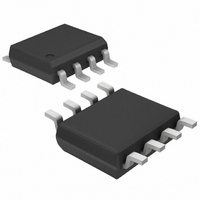MAX13487EESA+ Maxim Integrated Products, MAX13487EESA+ Datasheet - Page 13

MAX13487EESA+
Manufacturer Part Number
MAX13487EESA+
Description
IC TXRX RS485/422 8-SOIC
Manufacturer
Maxim Integrated Products
Type
Transceiverr
Datasheet
1.MAX13487EESA.pdf
(17 pages)
Specifications of MAX13487EESA+
Number Of Drivers/receivers
1/1
Protocol
RS422, RS485
Voltage - Supply
4.75 V ~ 5.25 V
Mounting Type
Surface Mount
Package / Case
8-SOIC (3.9mm Width)
Data Rate
0.5 Mbps
Operating Supply Voltage
5 V
Supply Current
4.5 mA
Operating Temperature Range
- 40 C to + 125 C
Maximum Power Dissipation
471 mW
Mounting Style
SMD/SMT
Lead Free Status / RoHS Status
Lead free / RoHS Compliant
on M2 and sets the SR latch, which also turns on M1.
Transistors M2, a 1.5mA current source, and M1, a 500µA
current source, pull RE to V
is designed to pull RE to the disabled state against an
external parasitic capacitance up to 100pF that can drive
RE high. After 15µs, the timer deactivates M2 while M1
remains on, holding DI high against three-state leakages
that can drive RE low. M1 remains on until an external
source overcomes the required input current. At this time,
the SR latch resets and M1 turns off. When M1 turns off,
RE reverts to a standard, high-impedance CMOS input.
Whenever V
reset. DI has similar hot-swap circuitry.
As with all Maxim devices, ESD-protection structures
are incorporated on all pins to protect against electro-
static discharges encountered during handling and
assembly. The driver outputs and receiver inputs of the
MAX13487E/MAX13488E have extra protection against
static electricity. Maxim’s engineers have developed
state-of-the-art structures to protect these pins against
ESD of ±15kV without damage. The ESD structures
withstand high ESD in all states: normal operation, shut-
down, and powered down. After an ESD event, the
MAX13487E/MAX13488E keep working without latchup
or damage.
ESD protection can be tested in various ways. The
transmitter outputs and receiver inputs of the
MAX13487E/MAX13488E are characterized for protec-
tion to the following limits:
• ±15kV using the Human Body Model
• ±15kV using the Air Gap Discharge Method speci-
ESD performance depends on a variety of conditions.
Contact Maxim for a reliability report that documents
test setup, test methodology, and test results.
Figure 10a shows the Human Body Model, and Figure
10b shows the current waveform it generates when dis-
charged into a low impedance. This model consists of
a 100pF capacitor charged to the ESD voltage of inter-
est, which is then discharged into the test device
through a 1.5kΩ resistor.
The IEC 61000-4-2 standard covers ESD testing and
performance of finished equipment. However, it does
not specifically refer to integrated circuits. The
MAX13487E/MAX13488E help you design equipment to
fied in IEC 61000-4-2 (MAX13487E only)
CC
drops below 1V, the hot-swap input is
______________________________________________________________________________________
Half-Duplex RS-485-/RS-422-Compatible
Transceiver with AutoDirection Control
CC
±15kV ESD Protection
through a 5kΩ resistor. M2
ESD Test Conditions
Human Body Model
IEC 61000-4-2
meet IEC 61000-4-2 without the need for additional
ESD-protection components.
The major difference between tests done using the
Human Body Model and IEC 61000-4-2 is higher peak
current in IEC 61000-4-2 because series resistance is
lower in the IEC 61000-4-2 model. Hence, the ESD
withstand voltage measured to IEC 61000-4-2 is gener-
ally lower than that measured using the Human Body
Model. Figure 10c shows the IEC 61000-4-2 model,
and Figure 10d shows the current waveform for IEC
61000-4-2 ESD Contact Discharge test.
The machine model for ESD tests all pins using a 200pF
storage capacitor and zero discharge resistance.
The objective is to emulate the stress caused when I/O
pins are contacted by handling equipment during test
and assembly. Of course, all pins require this protec-
tion, not just RS-485 inputs and outputs.
The Air-Gap test involves approaching the device with a
charged probe. The Contact-Discharge method connects
the probe to the device before the probe is energized.
Figure 9. Simplified Structure of the Receiver Enable Pin (RE)
RE
TIMER
TIMER
V
CC
5kΩ
M1
100μA
V
CC
500μA
15μs
M2
SR LATCH
Machine Model
RE
(HOT SWAP)
13









